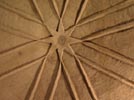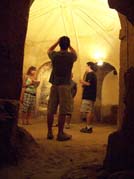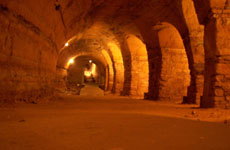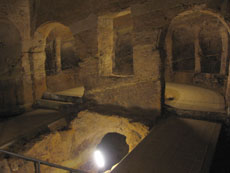Exploring
Camerano's
Underground Mysteries: The Grotte
By: Allison Fisher |
Camerano has
a secret beneath its streets.

Virtual tour of Camerano's
Grotte
(QuickTime movie)
Photos

The star dome in the Grotte
di Palazzo Corraducci is a special attraction unique to this
cave.

This is the opening of the
Grotte Manciforte e Costanini leading down 60 feet of stairs
to the bottom of the cave. This is the deepest cave available
to the public at this point in time.
Story written
by:
Allison Fisher
Web Design
by:
Kiley Peters
All Photos
by:
Kiley Peters
Video by:
Elliot Yancy
|
| Camerano,
Italy- More than 60 feet below the winding stone streets
of Camerano is a mysterious complex of elaborately intertwined
tunnels and niches. The Grotte, or caves, are buried beneath
centuries of folklore. With 17 known entrances, this intricate
three-level complex is one of the town’s hidden jewels. |

Grotte Manciforte e Costanini
There are many caves that run underneath Camerano, this
cave, Grotte Maniforte e Costanini, is charted as the deepest
cave open to the public at about 60 feet underground.
|
Despite
years of legends and taboos, Alberto Recanatini, a local historian
and author, decided to dig deeper for the facts. His research
has resulted in an extensively documented book “Le Grotte
del Conero” (“The Caves of the Conero”).
He recounts important discoveries about the origins and past
cultures of the Grotte’s inhabitants, including some
dating back thousands of years.
More than 150 tombs have been found in Camerano and surrounding
areas. The Picens, a people living in pre-Christian times,
were the first documented settlers between the 7th and 4th
millennium B.C., according to Recanatini. Later, the caves
and land of Camerano came under Roman control. |
| This
hidden preserve was partially opened to the public in 1997.
According to legend, the Grotte are a sacred space whose spiritual
intensity increases with depth. The caves symbolically represent
purity and are typically associated with light and darkness,
life and death, and creation and destruction, Recanatini says.
|
| The
Grotte served various purposes over time. Whether for religious
rites, shelter, water collection or storage, the sandstone
caves connected the town. These caves under the fields primarily
served for water collection, while those under the city center
were used more for storage and religious rites.
Vaulted, domed or arched niches and tunnels in the caves
are adorned with religious symbols. One of the structures
can been seen as imitating the Knights of the Round Table
while another hall resembles the tomb of Jesus Christ in Jerusalem,
according to Recanatini. |

Located underneath the San Francesco church,
this room is appropriately referred to as "La Chiesa"
which translates to "the church." This room is attached
to the Grotte di Palazzo Ricotti.
|
The dome
“star” structure defines the Grotte as a beautiful,
planned project, Recanatini says. The “star” dome
was used by the Knight Templar, an ancient religious order,
as a meeting place in Medieval times.
During World War II, the people of Camerano hid from the fighting
and bombing in the Grotte during a key month in 1944. Recanatini
was 6 at the time, “It is interesting to think of the
caves as saving us. Everybody came down. No one told us to come.
Life went underground.” Women, children and older people
fled beneath the surface as Americans troops arrived to fight
the occupying Germans, he says. The compartments lining many
of the narrow passageways below ground served as homes for many
families during those 20 days. As the men fought off the Germans,
teenagers were sent into the fields to stealthily collect food.
|
 A tour group admires the star ceiling in the
Palazzo Corraducci, a unique feature of this cave.
A tour group admires the star ceiling in the
Palazzo Corraducci, a unique feature of this cave.
|
The
three caves are now open to the public: Palazzo Ricotti, Palazzo
Corraducci and Palazzo Mancinforte. Each has its own identities
and symbolism. All became the property of wealthy families
that built their houses, or palaces, on top of the caves.
Many used the niches, which have an average temperature of
57 degrees, to store wine and firewood.
Restoration has taken place slowly to re-establish the city
under the city. Bricks and cement have been laid in various
areas to help structurally support the historic ruins. |
Many of
the caves, some of which are legally owned by families, are
closed off because of dangerous conditions or privacy. If the
caves are under the piazza (town center) or Town Hall, they
are considered public grounds.
A project led by Camerano’s mayor, Carmine DiGiacomo,
is now underway to buy all the caves, unblock the passages and
re-open them as a museum. |
|
Home | About
Camerano Project | Contact
Us
Arts
& Entertainment | Sports
| Family
& Faith | Commerce
| Community
Life | Index
Copyright ©2006 The Institute
for Education in International Media
|

